Spruce trees add life and color to your garden all year round. These hardy evergreen trees are great for any landscape. However, you should give the proper care to avoid its decline. This article will help you learn what to do when your spruce tree is dying.
Insects and plant diseases cause spruce trees to die. The poor soil conditions and environmental changes also contribute to the decline of the trees. You should immediately remove the affected leaves and branches to avoid spreading to the healthy parts.
There are preventive measures to place so the spruce trees continue to live. The proper care for the trees is key to their longevity. Read along to understand how to manage spruce trees.
![A huge plantation of dead Spruce trees due to infestation, Spruce Tree Dying—What To Do? [Inc. From Bottom Up, Top Down, One Side, & Inside Out]](https://gardentabs.com/wp-content/uploads/2022/09/Spruce-Tree-Dying—What-To-Do-Inc.-From-Bottom-Up-Top-Down-One-Side-amp-Inside-Out-Pin-683x1024.jpg)
Why Are Spruce Trees Dying?
Spruce trees are common in high elevations of most northern states in the United States. Although native to cooler locations, some species thrive across any state.
![A huge plantation of dead Spruce trees due to infestation, Spruce Tree Dying—What To Do? [Inc. From Bottom Up, Top Down, One Side, & Inside Out]](https://gardentabs.com/wp-content/uploads/2022/08/Spruce-Tree-Dying—What-To-Do-Inc.-From-Bottom-Up-Top-Down-One-Side-amp-Inside-Out.png)
The tree is about 70-80 feet at its maturity and can live for around 600-800 years.
Sadly, environmental changes are leading to a decline in spruce trees. The climate of each state varies, and the changes shock and stress the trees in the new environment.
The spruce can get heat and drought damage in hotter states. The high temperatures cause the foliage to become dry, brittle, and dead.
As a result, spruce trees become more susceptible to infections from insects, fungi, and pathogens.
Listed below are the common diseases on spruce trees:
- Needlecasts - A fungal infection that causes the shedding of needles of the current year's shoots.
- Tip blights - The new and emerging shoots die back due to this fungal disease.
- Canker diseases - The target spots of the fungi are the branches and the tree's main stem. It results in flagging, which is the inability of the branches to take in water and nutrients.
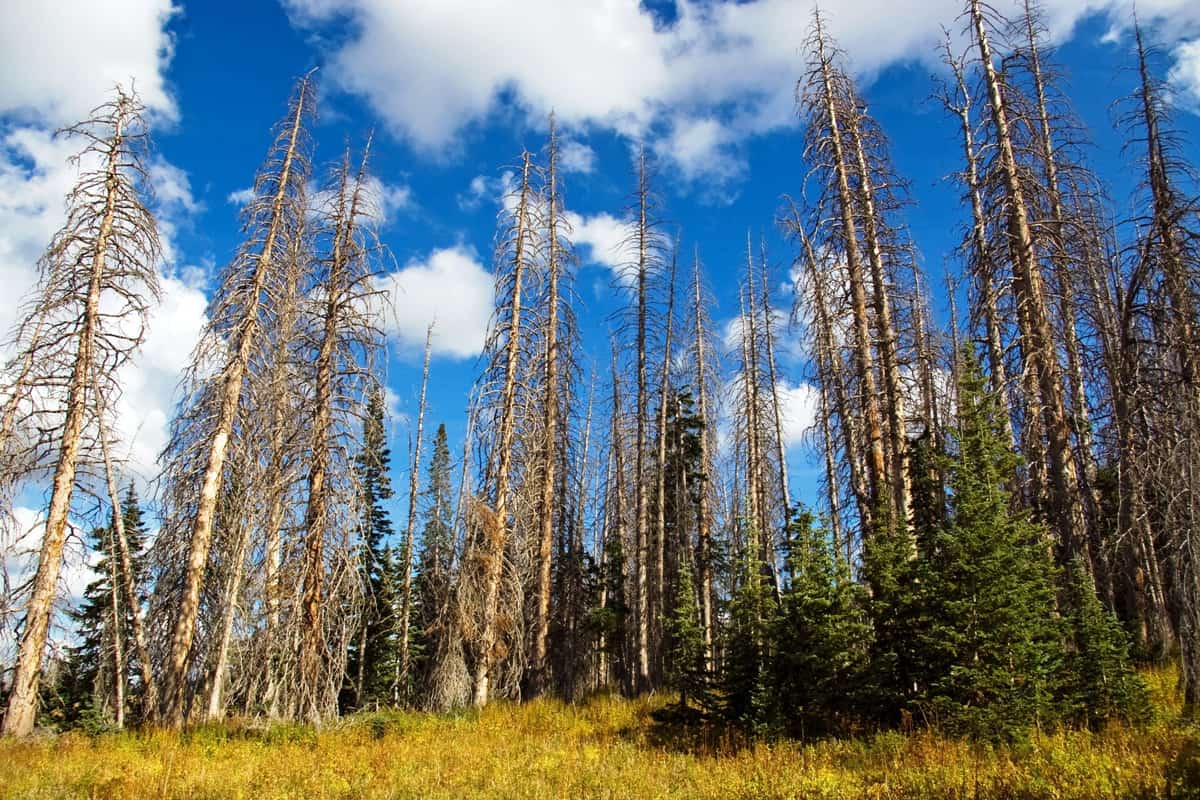
Aside from diseases, the common insects that affect spruce trees are :
- Gall adelgids
- Pitch mass borer
- Spruce budworms
- Spruce spider mites
- Yellow-headed spruce sawfly
The effects of those mentioned above depend on the tree's current state and its environment. Continue reading to learn how to identify damage in your spruce.
Patterns Of Spruce Tree Dying
There are several signs that your spruce tree may be sick or dying. The patterns depend on where the infection started. Read below about these patterns and how to tackle the issues.
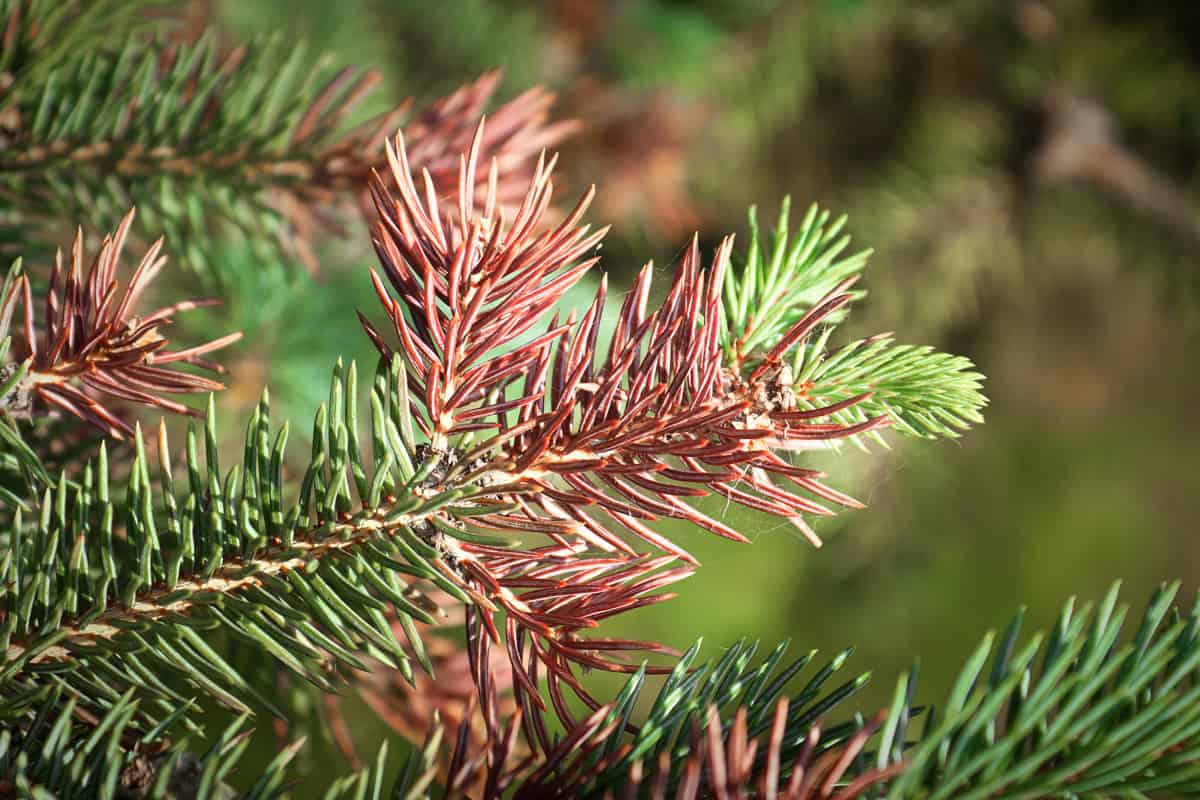
Spruce Tree Dying Bottom Up
There are several reasons causing the spruce tree to die from the bottom going up.
First, the upper branches do not allow enough sun to reach the lower branches.
Another reason is the Cytospora canker fungus that attacks the lower branches. Sadly, there is no available treatment for cankers. You must remove the dead branches and cankers to stop the spread to other healthy parts.
The trees can also encounter needle-cast fungal infections. The needles will start dying from the bottom of the tree's canopy and moving up.
Spruce Tree Dying Top Down
The harsh winter winds and scorching sun threaten the treetops of spruce trees. In effect, the needles become brown or purple during the late winter or early spring. You can apply an anti-desiccant spray on the trees during fall to avoid winter injury.
Pests and diseases target the tree from the top going down, such as bark beetles and white pine weevils.
Moreover, the soil condition can also contribute to the damage to the treetop. The current soil properties might not be rich enough to give nutrients to the tall spruce tree. The water and nutrients may not reach the tree's highest branches.
The treatment for this pattern depends on the circumstances of the spruce trees.
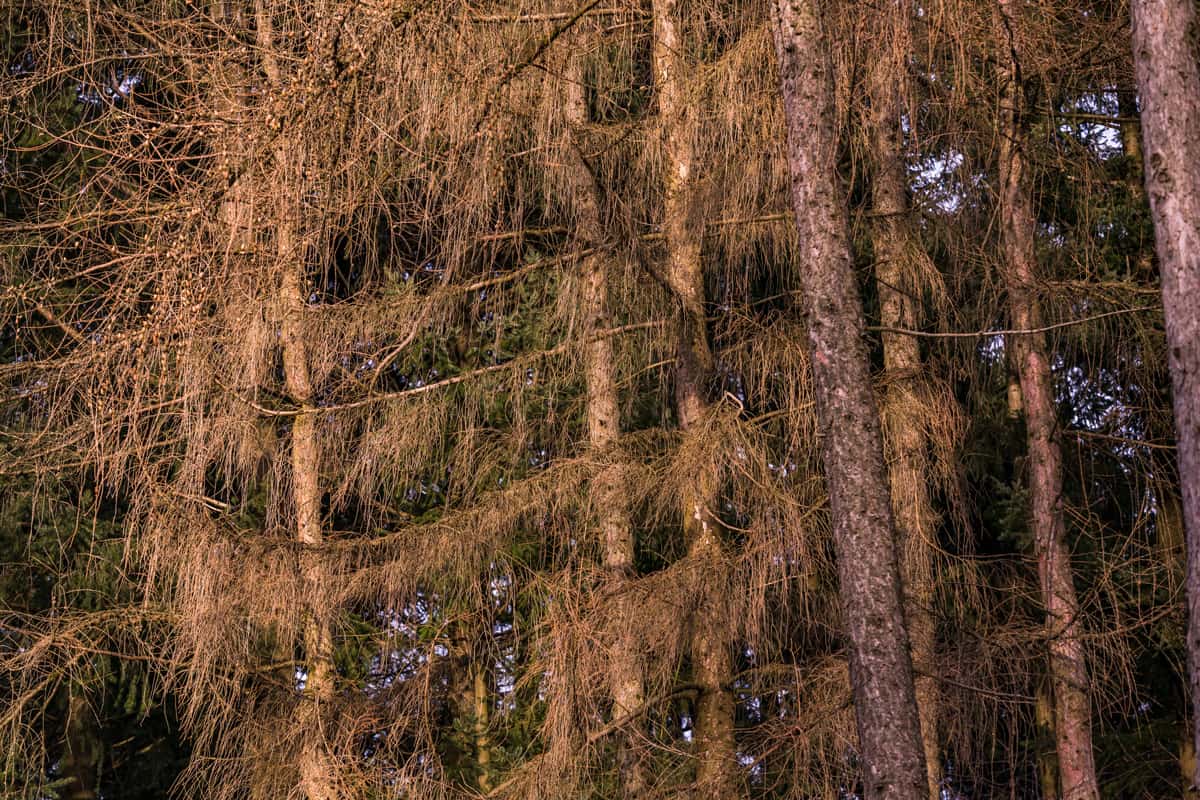
Spruce Tree Dying On One Side
The trees can experience sunscald that discolors the needles on one side. The dry winter air, low soil moisture, and the intense sun will dehydrate the needles. The extent of the exposure depends on the positioning of the tree.
You can prevent the damage with proper winter watering. For added protection, you should cover the tree with a breathable fabric, such as burlap.
Besides the weather, animals like deer can disfigure the tree by eating the foliage.
Spruce Tree Dying Inside Out
It is a challenge to control the damage from the inside of the spruce tree. Fungal diseases usually brought by the Cytospora canker are deadly for the spruce tree trunks. The needles turn brown or purple, then will fall off. You will see dying branches anywhere on the tree.
If you do not control the spread of the fungus, the tree can die.
Regardless of where the damage starts, you should know how to deal with the issues to save the spruce tree.
What To Do With A Dying Spruce Tree?
The most important task to do once you see that the spruce tree is dying is to prune diseased and dead parts. The infestation and damage from fungi and pests are evident in the contaminated parts.
Do not add the cuttings to the compost pile as the fungi and other bacteria can spread. Sterilize the cutting tools when pruning to avoid the spread of bacteria to healthy parts.
Let the tree recover and check its condition if it gets worse. Allow the tree to naturally heal itself. Give the right support like water and nutrients while you patiently wait.
Can Spruce Trees Regrow Needles?
Yes, the spruce tree can grow new needles if the cause is a natural one, like leaf burns. As long the branches are still alive, the needles regrow in due time. Otherwise, no needles will grow.
In addition, the needles will not grow new ones if the spruce yellow-headed sawfly attacked the trees. The sawfly larvae feed and camouflage on the needles. The attacks occur from early June to early July.
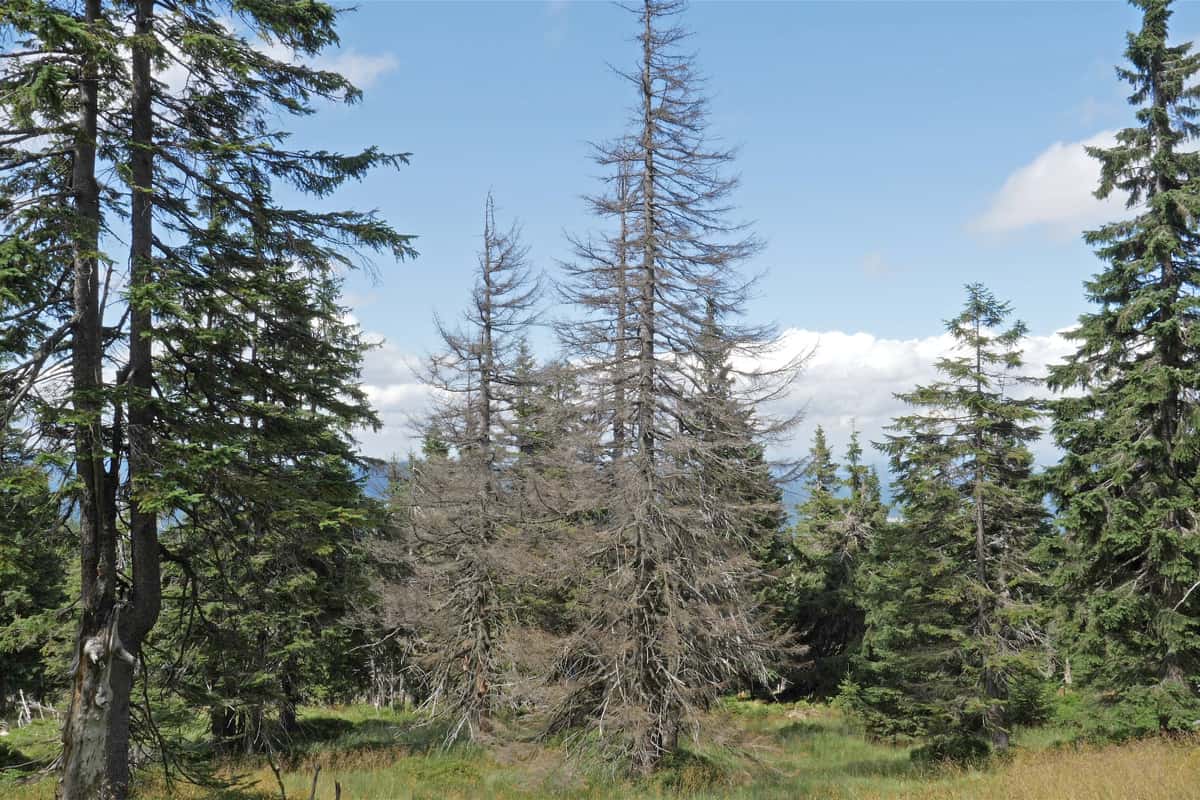
In effect, the needles will never come back. It can take around 3 years before the tree dies.
Should You Cut Down A Dying Spruce Tree?
If your spruce trees have a disease, you do not need to cut them down immediately. Even if the branches die and fall, they will grow back. You have to diligently remove the diseased parts and wait for the growing season.
You can cut the dead lower limbs of the tree during the dormant winter season. The dead limbs will not regrow as the tree ages. Remember to avoid the healthy branches and limbs.
Other reasons that you can remove limbs, also known as "limbing up," from your spruce tree are as follows:
- Removal of overlapping branches of a new tree from a nursery.
- There are two "leader" limbs at the top of the tree. Wait for at least a year to cut the redundant limb.
- Preventing further damage against diseases to the tree.
In the end, it is up to you if you want to remove the tree because it is untreatable even after your best efforts. If you do, you should replace the spruce tree with another disease-resistant tree.
If you decide to retain the tree, it can recover if you follow proper maintenance practices.
How Do You Recover A Dying Spruce Tree?
There are preventive measures you can do to help the spruce trees recover. Follow the tips below:
- Prune the dead and diseased branches during dry seasons. Also, prune the lower branches for improved air circulation.
- Spray the tree once every spring or early summer with the appropriate fungicide. Avoid chlorothalonil-based fungicides as this will discolor the needles.
- Provide deep watering to the tree once a week. Give at least 12-15 inches deep of water.
- Apply a horticultural oil or miticide from early June to early July.
- Before winter, protect the trees with a windscreen or similar plant covers.
- Properly mulch the root spread region to improve moisture retention of the soil.
- If you have sprinklers in the area, direct the water away from the tree.
It will seem overwhelming and tedious, but these tips are essential to keeping a healthy spruce tree.
In Closing
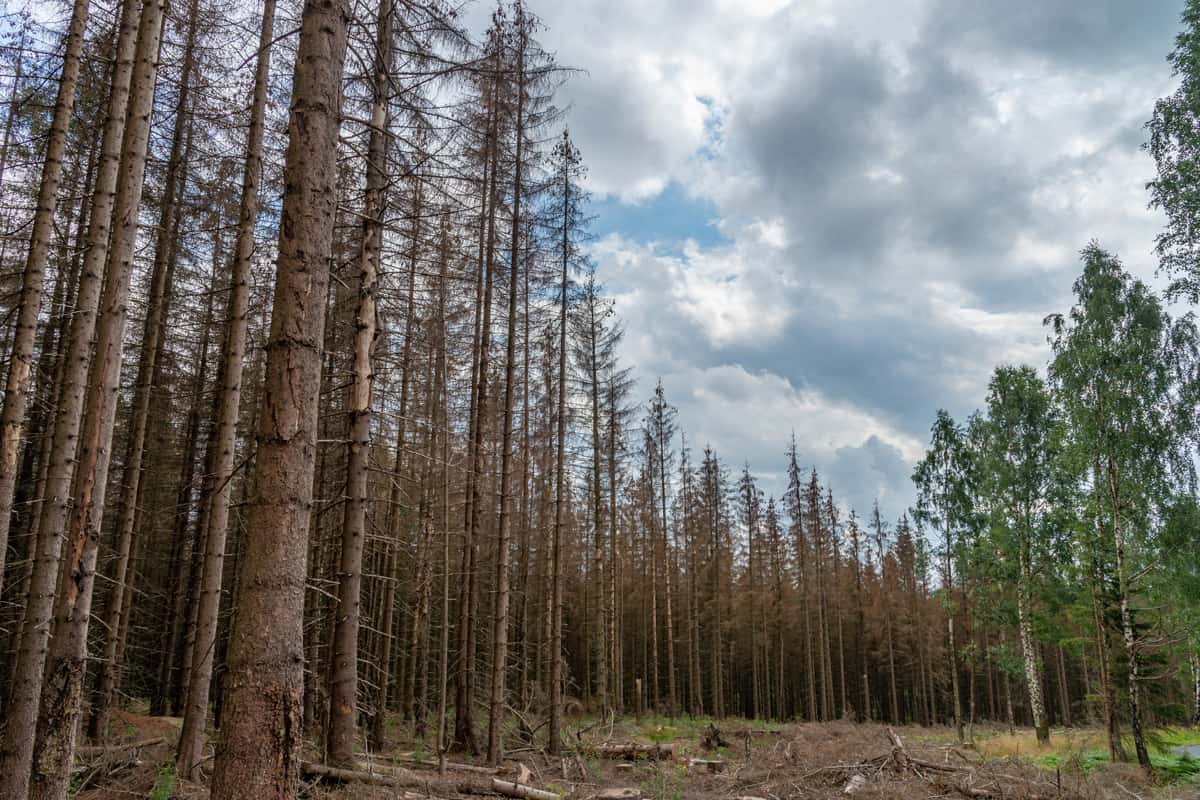
Spruce trees are vulnerable to disease and certain harmful insects. The symptoms of these diseases and pests usually manifest in the needles and branches. There are different patterns where the tree starts dying. The signs will show from top-down, bottom-up, on one side, or inside-out.
Be careful when your tree appears to be dying. You can wait for the tree to recover on its own, but you need to remove diseased and dead parts to avoid the infection spreading to the healthy parts of the tree. It might be necessary to cut down the tree if there is no way to revive it.
There are ways to control other fungi and pests to attack the spruce trees. Unfortunately, some fungi like the Cytospora cankers have no treatment. Proper care for the trees will help minimize the impact of the diseases.
Read more about trees from these posts:
How To Tell If A Fig Tree Is Dead
Why Is My Norfolk Island Pine Dying? [And What To Do About It]
